Expert Q&A: DJ Bandrowski
By Amy Nelson
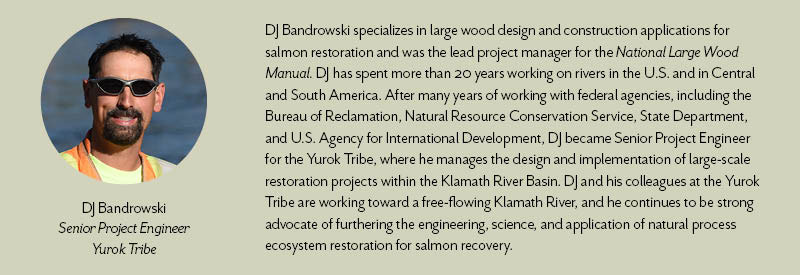
For people unfamiliar with the concept of reintroducing large wood into fluvial ecosystems, what are the benefits of doing this?
There are two categories of benefits: physical and biological, and there is an interplay between the two. Wood creates a physical complexity within fluvial ecosystems, and that complexity can drive different physical processes. Large wood jams often mimic hard points in the river that often become a catalyst for physical change. Wood causes flow obstruction that helps change the physical nature of the river, both vertically and horizontally. It has both erosional and depositional characteristics that make the river more complex.
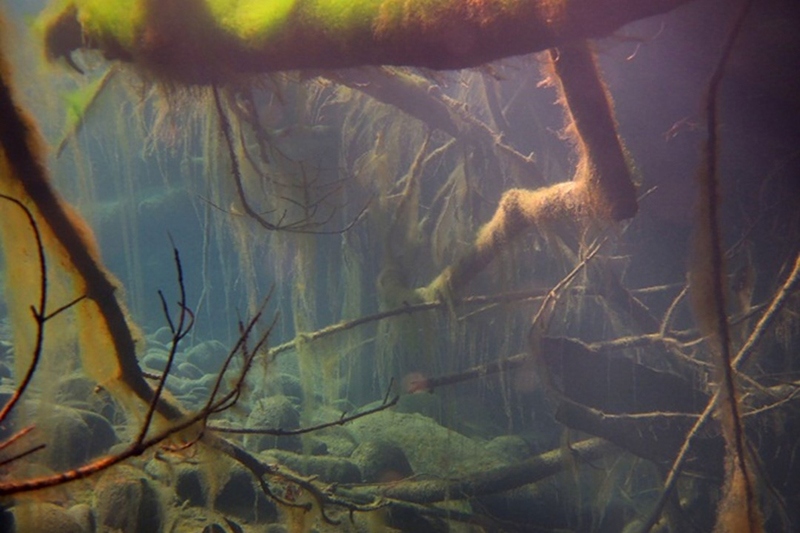
That physical change and complexity creates an environment that can be more conducive for juvenile and adult salmon, as well as other aquatic and terrestrial organisms. Often, adult fish use the deep water in front of a wood jam as habitat, while juvenile fish take refuge in the interstitial space of the wood jam. In the backwater of the wood jam, juvenile fish can feed and be protected from predators and high flows. Wood jams also trap bugs or leaf litter containing bugs that promote a functional food web. Wood jams have been a component of healthy river systems forever.
What are the different types of large wood structures that are being designed and installed in rivers and streams as part of ecological restoration?
I don’t like to use the word “structure” because that implies something engineered that does not move. I prefer the term large wood “elements” or “complexes.” I think of these elements as falling into three categories, based on the goal of the project.
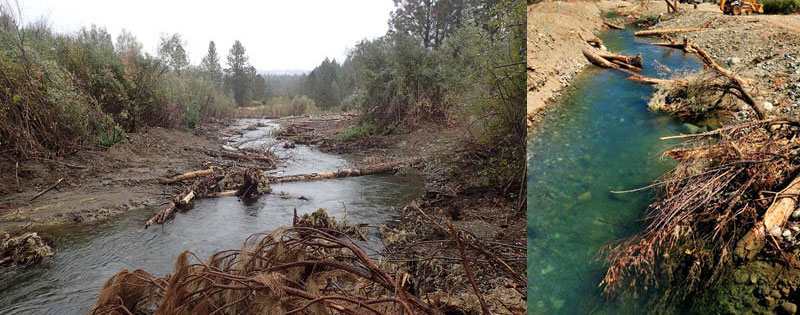
A habitat element, which could be one to five pieces of wood used together, is used when the primary objective is to create habitat complexity.
A hydraulic complex is used when the primary objective is to interact with the hydraulics to meet a certain design objective, such as bifurcating flow into a side channel network.
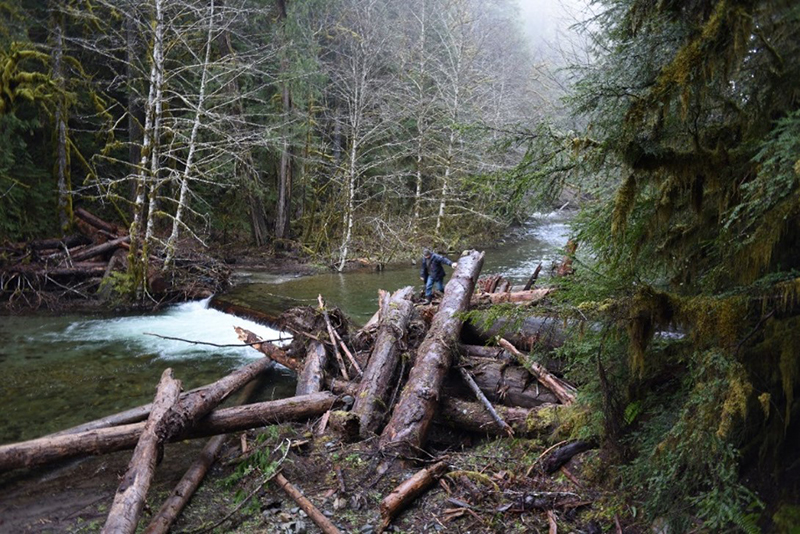
A geomorphic complex (also called an “engineered log jam”) is used when the primary objective is to drive geomorphic processes. These jams mimic large accumulations of wood in rivers that would have a very large hydraulic signature. These wood jams might push the entire flow of river from one bank to the other, or create a large, hydraulic disturbance that creates a very deep scour hole, for example. Each one of these categories comes with its own set of design criteria and rigor.
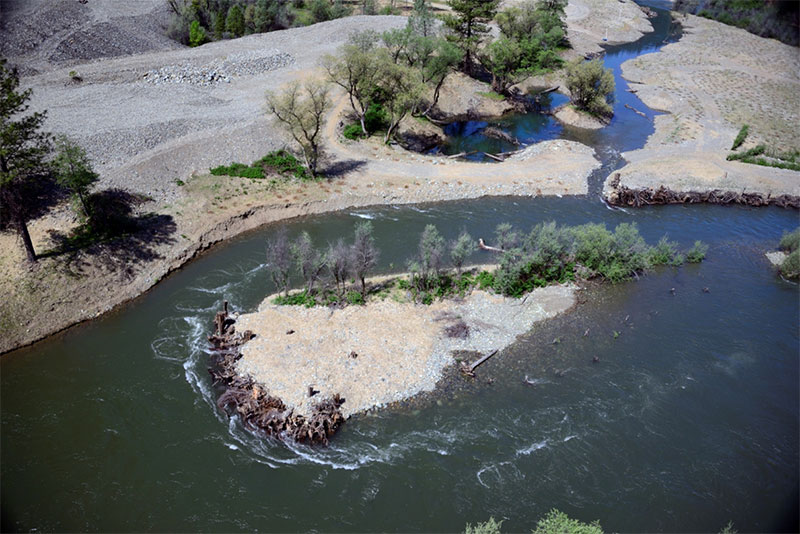
Geomorphic complex. Photo: courtesy of DJ Bandrowski
Speaking of design rigor, you were a lead technical editor of the National Large Wood Manual, a guide produced jointly by the Bureau of Reclamation and the USACE. Why was this guide produced?
We produced this guide because, from a Federal standpoint, we were spending a lot of time and money doing ecological restoration using wood, but there weren’t a lot of guidelines out there. We needed to be sure that we were considering all aspects of this practice—everything from stability and risk to biological response and long-term benefits. We needed to make sure we weren’t missing steps and putting practitioners at risk by promoting large wood without having good guidelines to consider.
In 2014, when I was with the Bureau of Reclamation, we brought together a group of researchers, engineers, government agencies, and practitioners for a week-long workshop to discuss the data gaps. The biggest thing to come out of that workshop was that we didn’t have a standard set of guidelines. My colleague at the US Army Corps of Engineers, Jock Conyngham, and I proposed that our two agencies partner together to fund and develop a set of large wood guidelines that could be used nationwide. We assembled a multi-disciplinary team of scientists and engineers who were experts in the field of large wood restoration to author various chapters of the manual. We also reached out to the broader restoration community to provide peer review throughout the process. After two years of extensive collaboration, the Bureau of Reclamation and US Army Corps of Engineers published the National Large Wood Manual in January 2016.” The manual can be downloaded.
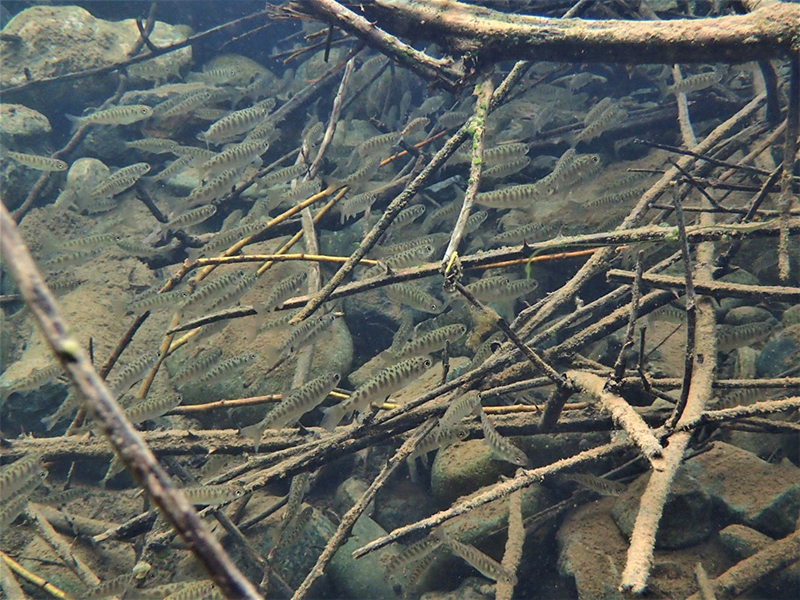
Are the guidelines in the manual applicable to all three types of elements you previously described?
Yes, absolutely.
Are people using the manual? What kind of feedback are you getting?
I am often told that the manual is a great accumulation of the scientific work and literature. The bibliography alone serves as a useful catalogue, in that it puts all of the work that so many scientists, engineers, and practitioners have done up to this point into one place so it can be more easily digested. Things will evolve, and new techniques will emerge, but for now, the manual provides one place people can go to better understand everything from the planning and design of large wood elements to the implementation and monitoring of them. We also hear that the manual is useful as a justification tool to help drive projects. Practitioners can say, “I didn’t just invent this thing. These guidelines are federally recognized and backed by scientific and engineering literature.”
We have had feedback that the manual has too much information. But this is not a cookbook exercise. Practitioners who ask, “What formula can I plug into my Excel spreadsheet to get the right answer?” will be disappointed because the manual is not an answer. It is a quest. You must look at all the scientific aspects, including the geomorphology and ecological conditions of the river as well.
The introduction to the guide states that “The failure of wood placements in restoration is entirely the fault of the design, not the material.” What is the number one mistake designers make when designing wood elements?
Different people will give you different answers to that question. I am of the philosophy that we are over-engineering and over-designing these elements with over-expectation of long term stability. Stability is often considered the most important aspect of these structures, and while it is very important, it is not always achievable when you are dealing with large rivers or large floods. When you try to harness nature by creating a stable condition, you are always going to lose. You’re never going to be able to create a structure that will never move. That’s not how nature works.
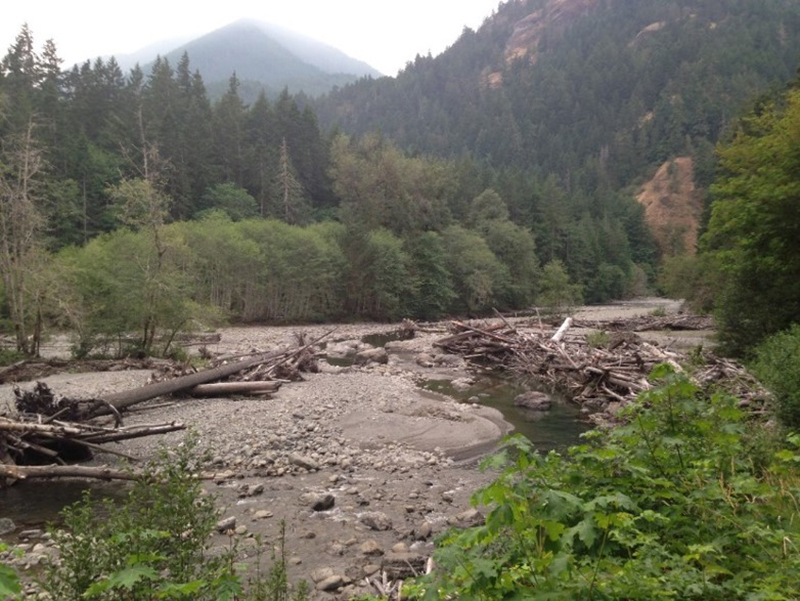
When you design a bridge, you want it to be stable because it’s public infrastructure. So you over-engineer it to withstand flows and processes in order to keep the public safe. Wood jams are different. You’re not designing a wood jam for public infrastructure; the goal is to promote physical and biological response. As engineers, we’re trained to be risk averse and make sure things are stable and immobile. So we have a dilemma: how do we create natural processes yet not put undue risk into the river? Many people’s quick response is to design for the hundred-year flood event, and cable structures together or place 36” diameter boulders. They try to lock it down. Designers often say, “I am forced to do this because the permit says I have to.” My response is that if the permit requires complete stability, but we know that is not achievable, then maybe we should reconsider if large wood is the best solution for the project. We’re almost doing a disservice to the restoration community by selling wood jams as completely stable. There might be certain situations where we shouldn’t even put wood jams in the river because there might just be too much risk below. Rather than trying to figure out a way to put in a structure just because a client is asking for it, there are times where we should consider the no action alternative.
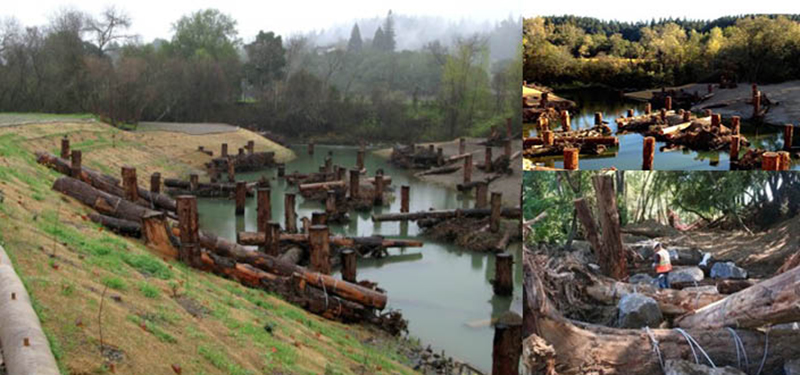
What are some other situations where the no action alternative is a good choice?
Certain rivers have different considerations, and the National Large Wood Manual goes into this in depth in terms of risk and public safety. If you have a recreational river, where there are a lot of kayakers or kids floating down the river in inner tubes, putting a 25-piece wood structure in the middle of the river and creating a hydraulic signature that promotes scour is not a great choice. We also have to consider public infrastructure. Are their houses nearby? Is it going to raise the flood elevation and impact someone’s water system? Is there a bridge downstream that could be impacted? Wood is going to interact with the flows to create physical processes. One of those processes is erosion. When a fallen tree creates erosion, and sediment moves downstream and creates a bar, and the bar bifurcates the flow into different channels, I’m slapping high fives with my colleagues, and saying, “This is awesome! Look at the physical processes and the biological response!” But the landowner is saying, “Wow. I just lost 30 feet of my real estate. Now I’m going to put in rock rip rap to stabilize that bank.” So we have to look at the goals and objectives of ecological restoration in terms of the people and communities associated with these projects. As scientists, biologists, geomorphologists, and engineers, we can design the best project ever. But if that project isn’t supported by and doesn’t directly involve the stakeholders, it will be a total failure.
I understand that negative perceptions of wood in rivers is a substantial obstacle to its reintroduction into aquatic systems. Can you share any strategies that have been helpful in addressing these negative perceptions?
The primary strategy is early involvement. We need to bring our stakeholders in at the 1% level of design, not the 50% level. And when I say involvement, I’m not talking about lip service. I’m talking about meaningful involvement. Find out what is important to them and have them help set some of the project goals. We restoration practitioners need to be better listeners. Stakeholders and land owners might not understand geomorphology, hydrology, and engineering aspects of restoration, but they look at the river every day and have a better understanding of that one spot than we do. They know where the river has come up to, and how dynamic it is. We need to harness that knowledge, understand how to incorporate it into the project, and bring stakeholders along the way.
The next strategy is to be honest, transparent, and up front with people about the potential evolution that will happen when you put large wood into the river. A lot of people will see an engineered log jam and say, “That’s really ugly. That pile of logs in the river doesn’t look right.” You have to explain that in order to have a wood complex that’s going to meet the goals of the project, it may not look visually appealing. Not trying to oversell that is important. You can’t say, “Oh, you’ll hardly notice it” or “it’s going to look great.”
When I was with the Trinity River Restoration Program, there was one site where we were designing a large island in front of a person’s house and the wood jam was going to be in front of the island. It was designed to split the flow and cause some physical processes and juvenile salmon rearing habitat. One of the project goals was to create erosional processes. One of my colleagues said, “We don’t want to tell [the homeowner] all of the things that could happen. We just need to get this thing in the ground.” I said, “No. We need to tell him exactly what could happen. We need to paint that picture, rather than sugar coat it. If we do, we’ll gain trust. If we don’t, that person will tell his neighbor on the next project that we can’t be trusted.”
In that case, we told the landowner that we were thinking of this project, and wanted to engage him early on. We told him that there would be a lot of benefit for fish and the river, but we said, “It is not going to look like it does from your front window now. It’s going to be large, and you might think it’s ugly. It’s going to cause erosion and it will erode your bank. The federal government is willing to pay you to do this project, but I just want you to know that you won’t get a permit to stabilize your bank after we’re done. We want you to really think about this. Saying no to us now is a lot better than saying yes and being disappointed later. I’d rather you think about this and ask a lot of questions, and if you don’t want to do the project, that’s okay.”
Going into it with that approach helped us build the trust with this landowner. He ended up saying, “I realize the potential cons, but I also see the pros, and I’m willing to go down this road with you,” and we did the project. He did say afterwards that it was not what he envisioned, though, and that brings me to another strategy: take land owners and stakeholders out to projects that have already been built so they can see a similar example. A picture in a book is not enough. I have been trained to interpret drawings in a top down, plan view format, but most people haven’t. You need to show them a different perspective, like an architectural rendering. Or go out on their property and lay it out. Show them where the front of the island and the end of the island would be. Those strategies can help convey the goals of the project.

The manual’s introduction also states that the ultimate goal is to restore the function of wood “until riparian forests are able to supply the large trees that can sustain those functions.” How do you ensure that kind of trajectory? How can you best ensure that wood placement is not a short-term solution?
We often end up creating these sterile wood jams that may be great for aquatic habitat, but not great for the riparian function. It is important to work with different disciplines to make sure that we incorporate riparian vegetation with the large wood to help restore full ecosystem function and promote more tree growth. Doing that helps ensure that over time, as erosion and depositional forces come into play, you’re going to recruit more wood through this long-term, evolutionary cycle.
You are now working for the Yurok Tribe. Has traditional ecological knowledge enhanced the practice of large wood reintroduction in any way? Are there lessons from traditional ecological knowledge that can be applied to LWD reintroduction?
When I was with the federal government, I worked with the Yurok and Hoopa Valley Tribes on the Trinity River Restoration Program, and I had gotten a sense of their dedication to the river and the salmon recovery. I ultimately went to work for the Yurok Tribe because I wanted to align myself with an organization that was as passionate as I was about doing restoration. (It meant leaving pensions and things like that behind, but this work is not about making money.) I love working for the Tribe. We are doing great projects across the Klamath Basin and beyond. We just completed a big restoration project on the South Fork of the Trinity River, and it was documented in the San Francisco Chronicle.
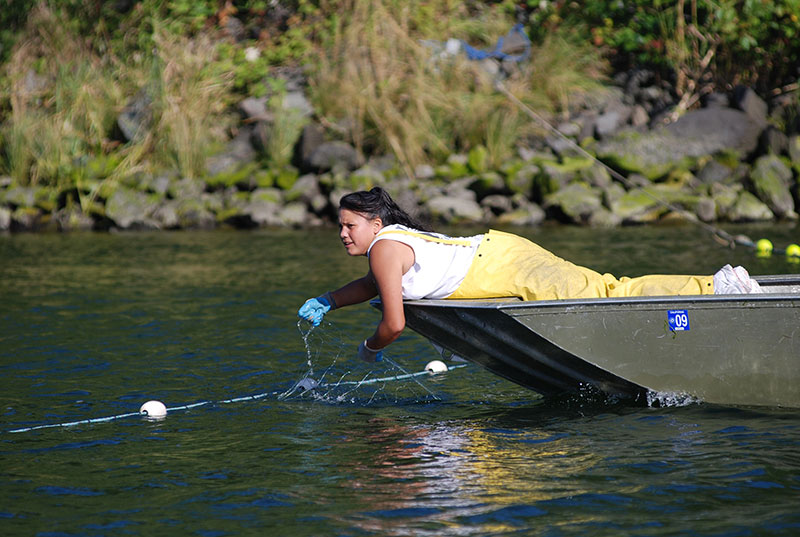
The Yurok Tribe is a fishing tribe. Salmon are considered their ancestors, and the river is considered their lifeblood. They respect the river and understand that a healthy river equates to a healthy community. If you look at tribal literature, you see that they recognized wood as an important component of river systems long before we did.
The Tribe has a philosophy that wood should be mobile and interact with the river. A lot of times, you see wood structures designed with cables, bolts, and artificial anchoring mechanisms. That is not the philosophy of the Tribe. They promote wood as an ingredient to a healthy river system and allowing the river to breathe and interact with the wood to shed and accrete in a natural process. New wood will come and rack up on a structure you put in, but maybe some wood erodes out and goes down to the next location, and that location becomes healthier and more dynamic. The Yurok believe that we need to respect the river’s ability to rearrange its environment to best promote a healthy system. It’s hard to embrace that as scientists and engineers because it means embracing uncertainty. That can be difficult when you’re trying to meet certain design criteria. We need to listen more to tribal elders about how wood has interacted with the river over time.
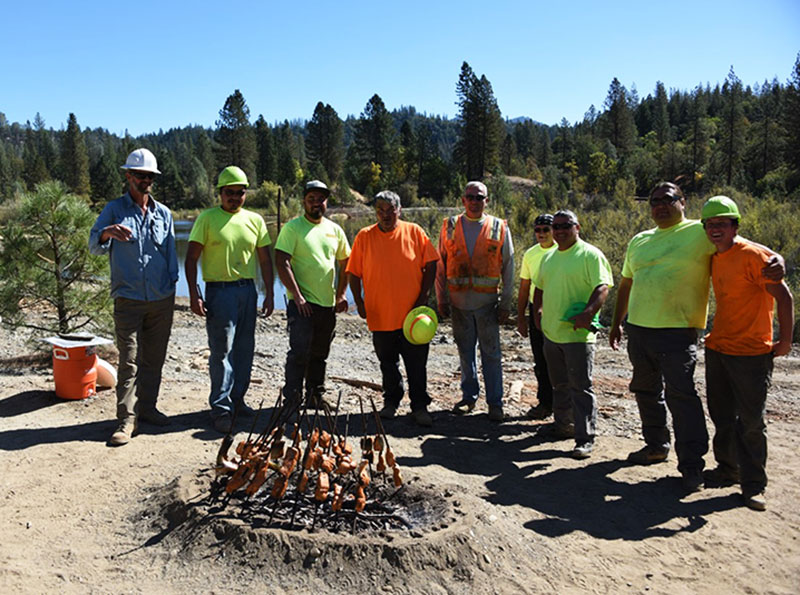
What kinds of regulatory hurdles do you typically encounter when reintroducing large wood to rivers?
Regulatory agencies are risk averse. They want assurance that the wood is going to be stable. This philosophy of mobile, dynamic wood, that doesn’t stay within the project boundary makes them uneasy. They ask, “How do you do the NEPA? How do you understand the environmental impacts if you can’t predict where the wood is going to end up and the evolutionary response to it?”
The regulatory framework can often be very rigid, but if you have the right people, it doesn’t have to be contentious. I’m working on a project right now where everyone is embracing the idea of dynamism and recognizing that the site will not look the same in the future as it does at the as-built condition. I’ve always said, “If the site looks the same as it did five years ago when we built the project, then we’ve done something wrong because we have not created the process and evolutionary response necessary for a healthy system.”
We don’t want a static project; we want a dynamic project. If you embrace that early in the regulatory world, then everybody can get on the same page and write that into the language in such a way that it can meet regulatory requirements.
With the project you just mentioned, how did you happen to have a cadre of regulators who embraced dynamism. Did you just get lucky, or did you do something to develop that comfort level?
Within the community of practice here [in the Pacific Northwest], people have had the opportunity to visit projects five years after they have been installed. When they physically see it—and not just understand it from a textbook or literature—they buy into it. I’ll often take regulators on a tour of projects that have been built. Spending a day on the river visiting sites creates this dialogue. They might say, “Oh, yeah, this makes sense, but I still have some issues with this thing. Tell me how we’re going to overcome that issue.” If we can start promoting dynamism within the regulatory framework, then we can work together to develop projects that embrace natural processes.
Is there any ecological basis or call for the use of large wood in ephemeral systems which are more common in the Southwest? If so is large wood being overlooked as a restoration – or even adaptation tool – in the southwest?
The new “Stage Zero” restoration strategies for valley-type applications involve restoring groundwater connectivity and water storage in the floodplain, and allowing groundwater to be more stable for a longer period of time. I think large wood is not used as much as it could be in those flashy systems of the Southwest. We could use wood to create grade controls and trap sediment and groundwater. This would allow for longer duration subsurface connections, which would create more riparian function, raise the groundwater table, and improve interaction with the floodplain. We often use the term, “slow it, spread it, sink it.” Doing that will yield more benefits from ecological, groundwater, aquatic, riparian, and floodplain functionality. Keeping the surface and subsurface water longer will be better for long-term cycles to help combat against climate change.
One day, if we are not careful we may have to do restoration of our restoration.
What research do you think is most urgently needed?
Understanding wood dynamics, in terms of wood transport characteristics. How can we better measure, quantify, and learn from how wood passes through the system. It’s an area that not many people can scientifically quantify, and it is very important in the international community. Knowing more about how wood moves through the system would also be helpful in developing wood budgets for restoration projects. There is research being conducted by great scientists on wood transport characteristics, but if we could really put more funding and energy toward it, we’d have a much better understanding, and we could incorporate that into our planning and designs.
In a presentation you gave about one of your restoration projects on the Trinity you shared a story about one of your first days of your professional career, when you were with the NRCS in Michigan. You described going to the site of a future wetland restoration project for some training with a seasoned civil engineering technician who was near retirement. You explained that the technician suddenly stopped, shook his head, and remarked that he helped drain that very wetland when he began his career. If you were to visit one of the sites where large wood has been used in river restoration twenty years from now with a restoration trainee, what do you think you’ll be seeing and saying?
I think that one day, the restoration community will be going back to a lot of these wood restoration sites where static structures were installed and take out the cables, bolts, and rebar. If we wanted to promote dynamism and ecological function we need to stop installing artificial anchoring and stop promoting this as something positive. We should always ask ourselves, “What are we putting on the landscape and in our rivers today that we might have to undo later?” One day, if we are not careful we may have to do restoration of our restoration.
